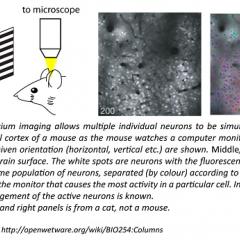Brain–Machine Interfaces: Melding Mind and Machine
It sounds like science fiction, but brain–machine interfaces (BMIs) are science fact. So what is a brain–machine interface? It’s probably exactly what you think (is that a pun?). Researchers record neuronal activity from a subject – typically either a human or a non-human primate – and use that information to guide the operation of some external device. This device could be a computer cursor, a robotic arm, or even an ‘exoskeleton’, a machine that wraps around a paralysed patient’s legs to assist their walking. The brain-mediated control of the machine doesn’t happen immediately; extensive training on the order of months is required, depending on the task to be learnt. But it’s easy to envision medical benefits of the technology, particularly for patients with spinal cord injury.
In two previous articles, I described some technologies used to record neuronal activity in humans and animals. Some of these technologies, in particular EEG, ECoG and multielectrode arrays (MEAs), have proven suitable for use in brain–machine interfaces. The differences in their suitability come down to trade-offs between their invasiveness and the level of control they allow, with EEG being least invasive but providing the poorest control, and MEAs providing the best control but requiring chronic electrode implantation.
In December 2014 a research team displayed improvements on the technology. Future research is aimed at providing the user with touch and proprioceptive feedback – coded directly into the brain – which should provide finer prosthetic control. There’s also the issue of portability for any brain–machine interface; wireless interfaces are being developed to help with this. Furthermore, a robotic arm operated via a BMI would ideally have individually addressable fingers, but this would require much more information to be decoded from the brain than is currently possible. Finally, there are longevity issues to be addressed – the brain signals recorded from the electrodes degrade over months to years, meaning less effective control of the prosthetic device. The development of improved electrode–brain interfaces through materials engineering will help in this regard.
Currently, the future of BMIs probably lies in their usefulness for patients with spinal cord injuries. But it’s important to remember that BMIs exist because of basic research, for example through research into MEA recording technologies, and into understanding how the brain represents movement information. Furthermore, as Professor Nicolelis acknowledged, BMIs won’t be the sole answer to spinal cord injury – direct spinal cord stimulation and rehabilitative training will also have significant impacts, and recent work has suggested that deep brain stimulation (DBS) – known primarily as a neural interface technology for managing Parkinson’s Disease symptoms – may prove useful. It’s completely unclear which approach is the most promising, and a fusion of several will probably prove the most beneficial.
Recommended Reading
QBI research into spinal cord injury: Professor Perry Bartlett
For more information on spinal cord injury, check out Spinal Cure Australia, for which QBI Director Professor Bartlett serves as Scientific Director.
QBI research on deep brain stimulation: Australia-Pacific Centre for Neuromodulation
A more detailed description of how BMIs work.


